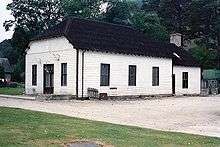Larder

A larder is a cool area for storing food prior to use. Larders were commonplace in houses before the widespread use of the refrigerator.
Essential qualities
- as cool as possible
- close to food preparation areas
- constructed to exclude flies and vermin
- easy to keep clean
- equipped with shelves and cupboards appropriate to the food being stored
Description
In the northern hemisphere, most houses would be arranged to have their larder and kitchen on the north or west side of the house, where it received the least amount of sun. In Australia and New Zealand, larders were placed on the south or east sides of the house for the same reason.
Many larders have small unglazed windows with the window opening covered in fine mesh. This allows free circulation of air without allowing flies to enter. Many larders also have tiled or painted walls to simplify cleaning. Older larders, and especially those in larger houses, have hooks in the ceiling to hang joints of meat or game. Others have insulated containers for ice, anticipating the future development of refrigerators.
A pantry may contain a thrawl, a term used in Derbyshire and Yorkshire, to denote a stone slab or shelf used to keep food cool in the days before refrigeration was domestically available. In the late medieval hall, a thrawl would have been appropriate to a larder. In a large or moderately large nineteenth-century house, all these rooms would have been placed as low in the building as possible, or as convenient, in order to use the mass of the ground to retain a low summer temperature. For this reason, a buttery was usually called the cellar by this stage.
Modern homes
Very few modern houses have larders, since this need is now satisfied by refrigerators, freezers, and the convenience of modern grocery stores that eliminate the need to store food for long periods.
Etymology
Middle English (denoting a store of meat): from Old French lardier, from medieval Latin lardarium, from laridum[1]
"In the past, and in many peasant societies, the pig has been a vital source of food for the winter: it can be salted and preserved, and traditionally you can eat every part of it except its squeak. This is reflected in the word larder, which in origin is a place for storing bacon. It comes from the French word meaning ‘bacon’ that also gave us lard (Middle English), and the lardon (Late Middle English), a cube or chunk of bacon."
History
In medieval households the word "larder" referred both to an office responsible for fish, jams, and meat, as well as to the room where these commodities were kept. It was headed by a larderer. The Scots term for larder was spence,[2] and so in Scotland larderers (also pantlers and cellarers) were known as spencers. This is one of the derivations of the modern surname.
The office generally was subordinated to the kitchen and existed as a separate office only in larger households. It was closely connected with other offices of the kitchen, such as the saucery and the scullery.[3]
Larders were used in the Indus River Valley to store bones of goats, oxen, and sheep. These larders were made of large clay pots.[4]
See also
References
| Look up larder in Wiktionary, the free dictionary. |
- ↑ "Larder". Oxford Dictionaries. Oxford University Press. Retrieved 2 March 2016.
- ↑ "Spence". Dictionary of the Scots Language. Retrieved 2 February 2016.
- ↑ Woolgar, C. M. (1999). The Great Household in Late Medieval England. New Haven and London: Yale University Press. pp. 111, 144. ISBN 0-300-07687-8.
- ↑ Mackay, Ernest John Henry (1948). Early Indus Civilizations (hardcover ed.). Luzak. p. 142. ASIN B0007IUIPM.